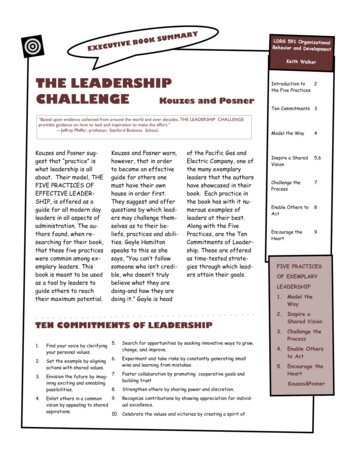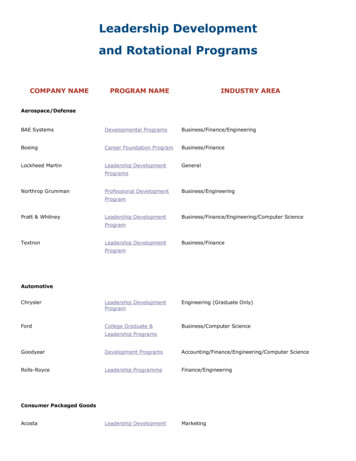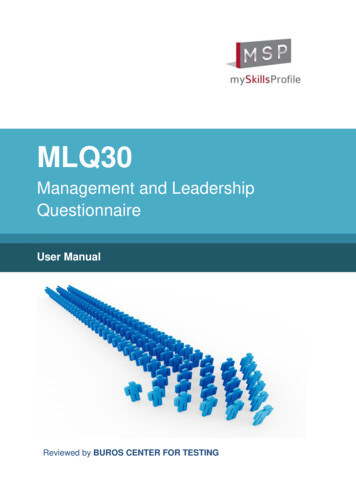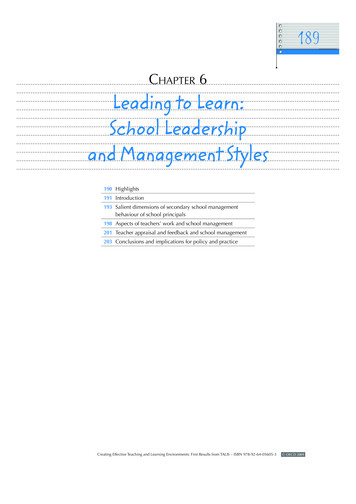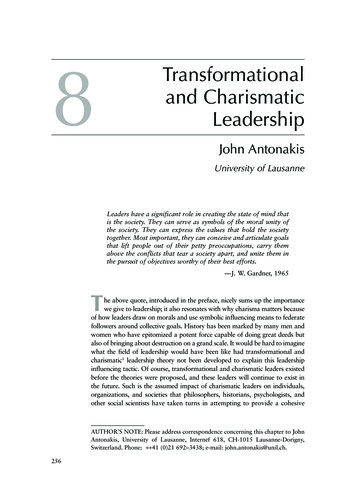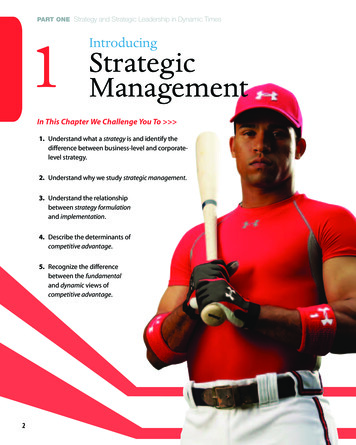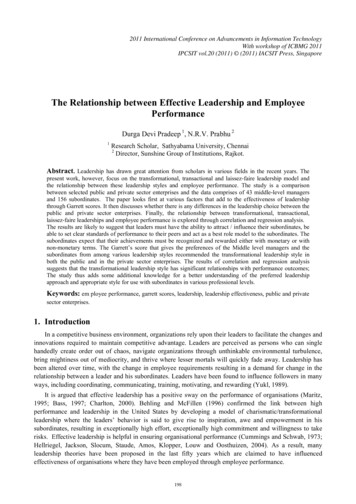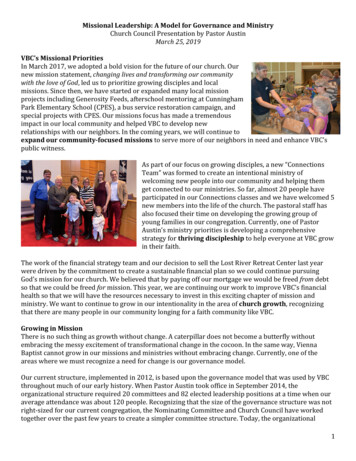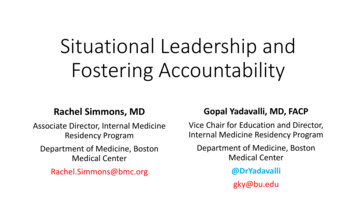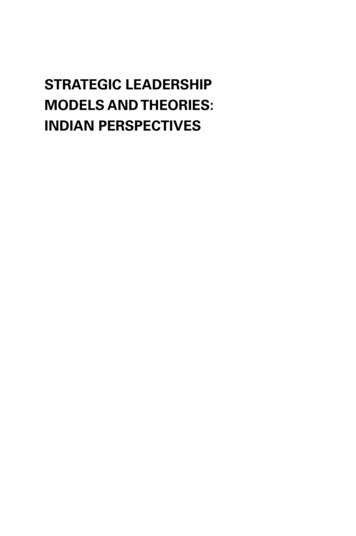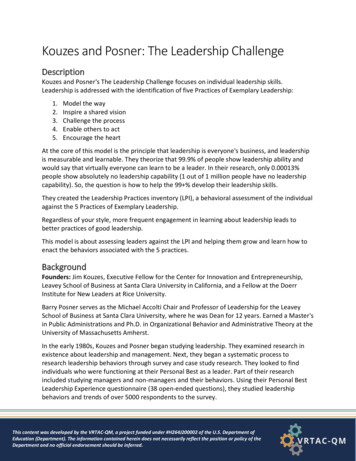
Transcription
Kouzes and Posner: The Leadership ChallengeDescriptionKouzes and Posner's The Leadership Challenge focuses on individual leadership skills.Leadership is addressed with the identification of five Practices of Exemplary Leadership:1.2.3.4.5.Model the wayInspire a shared visionChallenge the processEnable others to actEncourage the heartAt the core of this model is the principle that leadership is everyone's business, and leadershipis measurable and learnable. They theorize that 99.9% of people show leadership ability andwould say that virtually everyone can learn to be a leader. In their research, only 0.00013%people show absolutely no leadership capability (1 out of 1 million people have no leadershipcapability). So, the question is how to help the 99 % develop their leadership skills.They created the Leadership Practices inventory (LPI), a behavioral assessment of the individualagainst the 5 Practices of Exemplary Leadership.Regardless of your style, more frequent engagement in learning about leadership leads tobetter practices of good leadership.This model is about assessing leaders against the LPI and helping them grow and learn how toenact the behaviors associated with the 5 practices.BackgroundFounders: Jim Kouzes, Executive Fellow for the Center for Innovation and Entrepreneurship,Leavey School of Business at Santa Clara University in California, and a Fellow at the DoerrInstitute for New Leaders at Rice University.Barry Posner serves as the Michael Accolti Chair and Professor of Leadership for the LeaveySchool of Business at Santa Clara University, where he was Dean for 12 years. Earned a Master'sin Public Administrations and Ph.D. in Organizational Behavior and Administrative Theory at theUniversity of Massachusetts Amherst.In the early 1980s, Kouzes and Posner began studying leadership. They examined research inexistence about leadership and management. Next, they began a systematic process toresearch leadership behaviors through survey and case study research. They looked to findindividuals who were functioning at their Personal Best as a leader. Part of their researchincluded studying managers and non-managers and their behaviors. Using their Personal BestLeadership Experience questionnaire (38 open-ended questions), they studied leadershipbehaviors and trends of over 5000 respondents to the survey.This content was developed by the VRTAC-QM, a project funded under #H264J200002 of the U.S. Department ofEducation (Department). The information contained herein does not necessarily reflect the position or policy of theDepartment and no official endorsement should be inferred.
Sample questions included the following: Who initiated the project?What made you believe you could accomplish the results you sought?What, if any, special techniques or strategies did you use to get other people involved inthe project?Did you do anything to mark the completion of the project at the end or along the way?What did you learn most from this experience?What key lessons would you share with another person about leadership from thisexperience?The basic tenet is that everyone can learn to be a leader. It is not intelligence/talent alone thatgets results; it's continuous practice and efforts that achieve results. The best leaders havecredibility on their side (honesty, forward-thinking, competence, and capacity to inspire). "You cannot command commitment; you must inspire it."DWYSYWD: Do what you say you will do!The five practices: Model the wayInspire a shared visionChallenge the processEnable others to actEncourage the heartKey themes: Be dependable and foster trust.Embody virtues you want your team to embody.Develop your team culture and vision.Stack wins/successes and celebrate them.Love what you do, love life, and love the people you serve.The Leadership Practices Inventory Assessment (LPI): Kouzes and Posner went on to create theLeadership Practices Inventory (LPI) Assessment. They identified six behaviors for each of thefive practices outlined above, for a total of 30 behaviors. These 30 behaviors were developedinto the LPI assessment tool. It has strong validity and reliability. This assessment is inclusive ofa self-assessment process as well as a 360 assessment; the 360 assessment is completed byteam members that know the leader in the workplace and who are willing to provide theirfeedback concerning that person in relationship to the 30 practices. The LPI components are outlined below:Self-Assessment: Completed by the individualThis content was developed by the VRTAC-QM, a project funded under #H264J200002 of the U.S. Department ofEducation (Department). The information contained herein does not necessarily reflect the position or policy of theDepartment and no official endorsement should be inferred.
LPI 360: Completed by 5-10 other people familiar with the person (manager, co-workeror peer, direct reports, or others familiar with the work behaviors/habits of the person)Completed forms go to an independent facilitator, who scores them by computer orhand.There are additional services offered through an LPI 360 process, which can include additionalreports, modules, and other resource materials.Four types of reports are possible from the LPI: Individualized feedback on LPI 360 feedback from others with a breakdown ofmost/least frequent behaviorsLPI Self-Report: A summary of the person's self-assessment on the 30 behaviorsReassessment Report: Used as a second assessment to report on an LPI 360 ; longerprocess with pre-/post-testing over an 18-month period of time (lets people assess howthey have changed over time)Group Assessment Report: If a team of people in a business work together, it is possibleto have the team go through the process and have a post-assessment report.People who complete the LPI assessment have access to Development PlannerVision BookPractice BookLPI HandoutsThe 360 includes added modules to challenge the leader in addition to numerous handouts tohelp them through the leadership challenge.The tool has been used for three decades. Kouzes and Posner have continued to study andupdate it during that time. They have developed further training options for coaches andfacilitators of the training and the LPI assessment. There have not been any major changes tothe model.PurposeKouzes And Posner created the Leadership Challenge to help leaders develop their ownleadership skills and help organizations to create a learning environment to create leaders.How It WorksThe Leadership Challenge is a structured, multistep model. There are varying degrees ofimplementation. The recommendation is that organizations interested in the model go throughthe training and complete the LPI. While not recommended, there are some organizations thatuse the five practices of Exemplarity Leadership and 30 behaviors as a comparison point todetermine areas that need attention.This content was developed by the VRTAC-QM, a project funded under #H264J200002 of the U.S. Department ofEducation (Department). The information contained herein does not necessarily reflect the position or policy of theDepartment and no official endorsement should be inferred.
Organizations looking to implement the model and complete the challenge need to bring LPIinto the organization and get certified. An LPI certified master will come and offer theLeadership Challenge training and conduct the LPI with their staff. Information on the certifiedmaster and the training schedule can be found on the Leadership Challenge website.The training includes the following: Staff are trained on the Leadership Challenge.Staff complete the Leadership Potential Inventory (LPI) which includes a self-assessmentand a 360 assessment.After classroom training, there is an option for one-on-one coaching, and mostorganizations choose that package.Individuals can go back to have a reassessment on the LPI.An organization or individuals may also decide to pursue further training to become acoach, facilitator, or a master trainer.Core Values, Principles and ConceptsThe core principle of the Leadership Challenge is that anybody can be a leader. Empathy andcompassion are critical skills and listening can help with empathy. The model helps leadersidentify the kind of leader they want to be.The Model is driven by the five Practices of Exemplary Leadership:1.2.3.4.5.Model the way.Inspire a shared vision.Challenge the process.Enable others to act.Encourage the heart.The Leadership Challenge also include the following five Fundamentals for Learning to Lead:1.2.3.4.5.Believe you can lead.Aspire to excel.Challenge yourself.Engage supports.Practice deliberately.FrameworkThe five practices and 10 corresponding commitments of Exemplary Leadership (From Kouzesand Posner, Leadership Challenge Workbook, 3rd Edition 2017):This content was developed by the VRTAC-QM, a project funded under #H264J200002 of the U.S. Department ofEducation (Department). The information contained herein does not necessarily reflect the position or policy of theDepartment and no official endorsement should be inferred.
Model the wayStrong leaders lead by example and are clear about their values. They demonstrate vs. talkabout their vision and values to help others understand. They embody the virtues desired inothers.Clarify values by finding your voice and affirming shared values.Set the example by aligning actions with shared values.Inspire a shared visionGreat leaders have a vision/dream they believe in and communicate their passion about it. Thevision keeps them forward-looking, and they show the team the way. Strong leaders build teamcohesion to achieve a shared vision/dream and make people feel they're doing useful work.Envision the future by imagining exciting and ennobling possibilities.Enlist others in a common vision by appealing to shared aspirations.Challenge the processLeaders overcome obstacles and look for new ideas or approaches; they think outside the boxand take risks. They stack small wins to build incrementally on them, and they learn frommistakes and move on to improve or try a new idea.Search for opportunities by seizing the initiative and by looking outward for innovative ways toimprove.Experiment and take risks by consistently generating small wins and learning from experience.Enable others to actStrong leaders foster collaboration through trust and relationships. They create a teamenvironment where everyone trusts each other. They involve everyone and help them toenhance their self-confidence and develop competence. They empower the team with a senseof ownership.Foster collaboration by building trust and facilitating relationships.Strengthen others by increasing self-determination and developing competence.Encourage the heart"Genuine caring uplifts the spirit and draws people forward."True leaders place emphasis on being authentic and sincere in their efforts. They model andnurture a positive working atmosphere of collaboration. They recognize efforts andThis content was developed by the VRTAC-QM, a project funded under #H264J200002 of the U.S. Department ofEducation (Department). The information contained herein does not necessarily reflect the position or policy of theDepartment and no official endorsement should be inferred.
contributions and celebrate and reward positive outcomes in-person and with unexpectedpositive feedback.Recognize contributions by showing appreciation for individual excellence.Celebrate the values and victories by creating a spirit of community.DiagramThe Five Practices and Ten Commitments of Exemplary LeadershipApplicationThe Kouzes and Posner principles are applicable to any type of organization since it focuses onleadership skills and not processes or operations. Individuals or teams in an organization canbenefit from learning to develop leadership skills. This is not about management skilldevelopment. It is about developing your personal leadership capacities. For organizationsinterested in using the Leadership Challenge training, visit Leadership Challenge - Become anExpert in Developing Exemplary Leaders. You will find information on the options forimplementing the Kouzes and Posner model.This content was developed by the VRTAC-QM, a project funded under #H264J200002 of the U.S. Department ofEducation (Department). The information contained herein does not necessarily reflect the position or policy of theDepartment and no official endorsement should be inferred.
Vocational RehabilitationIn 2014, Missouri VR decided to implement an Emerging Leaders Training for the agency as partof their succession planning. They hired a Consulting Team (former VR Leadership) to developthe program. The training builds on Kouzes and Posner's Leadership Challenge and includes theLPI. The training is voluntary and offered once annually with the cohort of 20 staff meetingthree times over the course of the year.The three phases of the training cover the following content: First session: Leadership Challenge principles applied to VR and DDSSecond session: Self-development (360 feedback, LPI inventory and CPI 260) and oneon-one consulting with staffThird session: Special considerations in leadership, broader vision/mission, legal andethical implications, social media, fiscal management, etc.The Emerging Leaders Training is currently on its seventh cohort. They have found that inaddition to addressing succession planning, it has been a good mechanism for professionaldevelopment, and there has been almost no turnover with the 120 staff who have gonethrough the training.Criticisms or ConcernsSince the model is focused on leadership styles and practices, it may be limited if leaders arenot at the management level. The model does not get into management practices. Trying to bea leader from a non-management role can have its challenges. Since major decisions andoperational issues fall into the management realm, non-management leaders don't drivechanges in these areas. There is the potential for non-management leaders to influence thosein management roles by making compelling arguments or proposals to them. There is also thepotential for a groundswell from the rank and file, influenced by peer leaders which may alsocatch the attention and favor of the management team.EffectivenessThis is a very effective leadership option, but it is costly. Each aspect of the LeadershipChallenge requires training as well as the LPI assessment and reporting protocols. Additionally,ongoing training and re-assessment options allow individuals or organizations to monitor theirprogress over time. There are also options for Facilitators and Mentors to emerge through atraining process. All of these training and development options are fairly expensive endeavorsfor an individual or agency.The Leadership Challenge model was based on the extensive research by Kouzes and Posner,who have continued to revise and update their tools and resources as their research on leaderspoints them in new directions or confirms their original hypotheses.A Doctoral Dissertation was done on Kouzes and Posner leadership practices and looked at theireffectiveness among elementary school principals. Another study, The Leadership PracticesThis content was developed by the VRTAC-QM, a project funded under #H264J200002 of the U.S. Department ofEducation (Department). The information contained herein does not necessarily reflect the position or policy of theDepartment and no official endorsement should be inferred.
Inventory: Theory and Evidence Behind the five Practices of Exemplary Leaders, was conductedin 2002.Recommendation for Use in VRThis could be beneficial to a SVRA trying to develop its pool of emerging leaders. Many stateagencies struggle as staff in senior management and management roles near retirement tohave an ample size group of emerging leaders in cue to assume their roles. This can includeroles from supervisors to the Director, and include other administrative roles, such as qualityassurance, training, data collection and reporting, and more. As agencies incorporatesuccession planning, this leadership training could help new and emerging leaders learn theirstrengths and enhance their skills in preparation for assuming different leadership roles.Certification TypesAs noted earlier, organizations can bring LPI into the organization by hiring a certified master toconduct training and the LPI assessments. Many organizations also choose to get staff certifiedas coaches and facilitators so that they have internal expertise and offer ongoing training forstaff.Coaches learn about the LPI Model and evidence of how it came to be. They get familiar withthe intricacies of the LPI reports, get trained on helping leaders in their organization byproviding feedback in group or individuals settings. They earn a certificate as a Trained LPICoach and have access to resource materials to help with coaching and the Coaches Guide toDeveloping Exemplary Leaders.Facilitators complete two full days of the Leadership Challenge, a Leadership is Everyone'sBusiness workshop, and the Challenge Continues session. They get trained on LPI LeadershipPractices, the LPI inventories, and guidance on how to debrief on LPI. They also get access toonline resources to help with training that includes activities tied to the five practices and acollection of general leadership activities.Options for TrainingThe Leadership Challenge Workshop and LPI for organizations: In-person or online (early birdrate is 2095/person for non-profits; four-plus people save 200/person)The Leadership Challenge Workshop and LPI for individualsBecoming a Leadership Challenge and LPI Coach: Prices combine prerequisites of Leadershipchallenge with coaching with a range of options. See details on site.Become a Trained Facilitator of the Leadership Challenge: Prices combine prerequisite trainingwith a range of options. See details on their site.This content was developed by the VRTAC-QM, a project funded under #H264J200002 of the U.S. Department ofEducation (Department). The information contained herein does not necessarily reflect the position or policy of theDepartment and no official endorsement should be inferred.
ResourcesWebsitesKouzes & Posner's The Leadership Challenge (A Wiley Brand) website outlines the training andassessment options: Articles and ReportsLeadership Practices Inventory Sample Individual ReportLeadership Practices Inventory Sample 360 feedback reportLeadership Practices Inventory Sample Reassessment ReportLeadership Practices Inventory Sample Group Assessment reportResearch Article: Bringing the Rigor of Research to the Art of LeadershipWebinarsLeadership ChallengeLearning Leadership with Jim KouzesPresentation Slides of 5 PracticesThis content was developed by the VRTAC-QM, a project funded under #H264J200002 of the U.S. Department ofEducation (Department). The information contained herein does not necessarily reflect the position or policy of theDepartment and no official endorsement should be inferred.
Kouzes And Posner created the Leadership Challenge to help leaders develop their own leadership skills and help organizations to create a learning environment to create leaders. How It Works The Leadership Challenge is a structured, multistep model. There are varying degrees of implementation.
